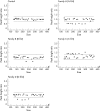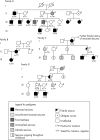Deletions or duplications in KCNQ2 can cause benign familial neonatal seizures
- PMID: 17675531
- PMCID: PMC2652819
- DOI: 10.1136/jmg.2007.051938
Deletions or duplications in KCNQ2 can cause benign familial neonatal seizures
Abstract
Background: Benign familial neonatal seizures are most often caused by mutations in the voltage-gated potassium channel subunit gene KCNQ2. More than 60 mutations have been described in BFNS families, approximately half of which lead to protein truncation. The hypothesis of this study was that deletion or duplication of >or=1 exons of KCNQ2 could cause BFNS in cases without coding or splicing mutations.
Methods: Multiplex ligation-dependent probe amplification (MLPA) was used to test a group of 21 unrelated patients with clinical features consistent with either BFNS, benign familial neonatal-infantile seizures or sporadic neonatal seizures, for exonic deletions and duplications.
Results: Three deletions and one duplication mutation were identified in four familial cases and cascade testing of their available family members showed that the mutations segregated with the phenotype in each family. The junction fragment for one of the deletions was amplified by PCR and sequenced to characterise the breakpoint and verify that a deletion had occurred.
Conclusions: Submicroscopic deletions or duplications of KCNQ2 are seen in a significant proportion of BFNS families: four of nine (44%) cases previously testing negative for coding or splice site mutation by sequencing KCNQ2 and KCNQ3. MLPA is an efficient second-tier testing strategy for KCNQ2 to identify pathogenic intragenic mutations not detectable by conventional DNA sequencing methods.
Conflict of interest statement
Competing interests: none declared.
Similar articles
-
Genetic testing in benign familial epilepsies of the first year of life: clinical and diagnostic significance.Epilepsia. 2013 Mar;54(3):425-36. doi: 10.1111/epi.12089. Epub 2013 Jan 29. Epilepsia. 2013. PMID: 23360469
-
Deletions involving both KCNQ2 and CHRNA4 present with benign familial neonatal seizures.Neurology. 2009 Oct 13;73(15):1214-7. doi: 10.1212/WNL.0b013e3181bc0158. Neurology. 2009. PMID: 19822871
-
A novel missense mutation (N258S) in the KCNQ2 gene in a Turkish family afflicted with benign familial neonatal convulsions (BFNC).Turk J Pediatr. 2007 Oct-Dec;49(4):385-9. Turk J Pediatr. 2007. PMID: 18246739
-
Sodium and potassium channel dysfunctions in rare and common idiopathic epilepsy syndromes.Brain Dev. 2009 Aug;31(7):515-20. doi: 10.1016/j.braindev.2009.04.012. Epub 2009 May 22. Brain Dev. 2009. PMID: 19464834 Review.
-
KCNQ2-Related Epilepsy: Genotype-Phenotype Relationship with Tailored Antiseizure Medication (ASM)-A Systematic Review.Neuropediatrics. 2023 Oct;54(5):297-307. doi: 10.1055/a-2060-4576. Epub 2023 Mar 22. Neuropediatrics. 2023. PMID: 36948217
Cited by
-
Genetic epilepsy syndromes without structural brain abnormalities: clinical features and experimental models.Neurotherapeutics. 2014 Apr;11(2):269-85. doi: 10.1007/s13311-014-0267-0. Neurotherapeutics. 2014. PMID: 24664660 Free PMC article. Review.
-
Genetically complex epilepsies, copy number variants and syndrome constellations.Genome Med. 2010 Oct 5;2(10):71. doi: 10.1186/gm192. Genome Med. 2010. PMID: 20923578 Free PMC article.
-
KV7 channelopathies.Pflugers Arch. 2010 Jul;460(2):277-88. doi: 10.1007/s00424-010-0831-3. Epub 2010 Apr 18. Pflugers Arch. 2010. PMID: 20401729 Review.
-
Copy number variation in a hospital-based cohort of children with epilepsy.Epilepsia Open. 2017 May 8;2(2):244-254. doi: 10.1002/epi4.12057. eCollection 2017 Jun. Epilepsia Open. 2017. PMID: 29588953 Free PMC article.
-
Extending the KCNQ2 encephalopathy spectrum: clinical and neuroimaging findings in 17 patients.Neurology. 2013 Nov 5;81(19):1697-703. doi: 10.1212/01.wnl.0000435296.72400.a1. Epub 2013 Oct 9. Neurology. 2013. PMID: 24107868 Free PMC article.
References
-
- Rett A, Teubel R. Neugeborenenkrämpfe im Rahmen einer epileptisch belasteten Familie. Wein Klin Wochenschr 196476609–613.
-
- Biervert C, Schroeder B C, Kubisch C, Berkovic S F, Propping P, Jentsch T J, Steinlein O K. A potassium channel mutation in neonatal human epilepsy. Science 1998279403–406. - PubMed
-
- Charlier C, Singh N A, Ryan S G, Lewis T B, Reus B E, Leach R J, Leppert M. A pore mutation in a novel KQT‐like potassium channel gene in an idiopathic epilepsy family. Nat Genet 19981853–55. - PubMed
-
- Singh N A, Charlier C, Stauffer D, DuPont B R, Leach R J, Melis R, Ronen G M, Bjerre I, Quattlebaum T, Murphy J V, McHarg M L, Gagnon D, Rosales T O, Peiffer A, Anderson V E, Leppert M. A novel potassium channel gene, KCNQ2, is mutated in an inherited epilepsy of newborns. Nat Genet 19981825–29. - PubMed
-
- Heron S E, Scheffer I E, Berkovic S F, Dibbens L M, Mulley J C. Channelopathies in idiopathic epilepsy. Neurotherapeutics 20074295–304. - PubMed
Publication types
MeSH terms
Substances
LinkOut - more resources
Full Text Sources




